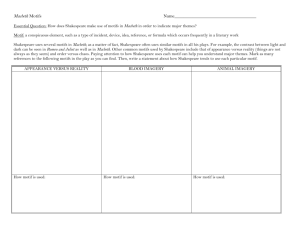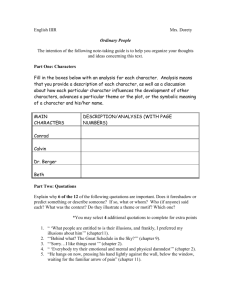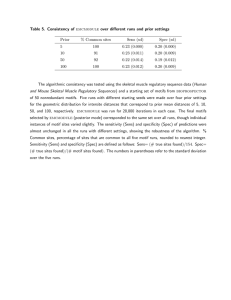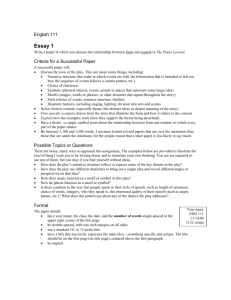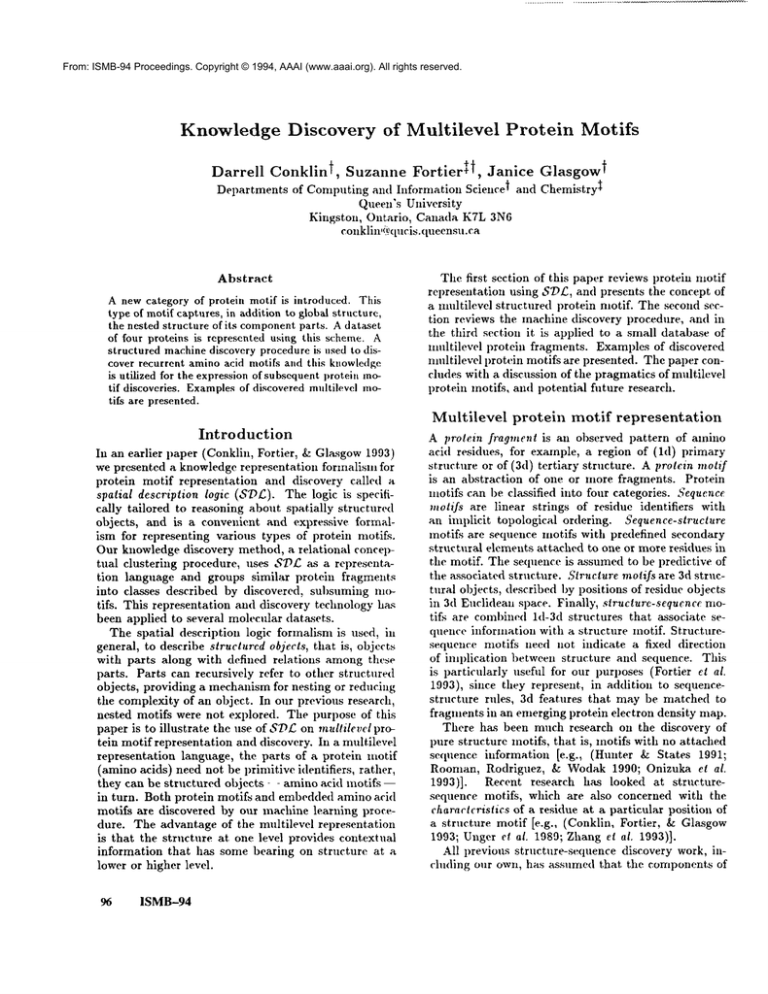
From: ISMB-94 Proceedings. Copyright © 1994, AAAI (www.aaai.org). All rights reserved.
Knowledge Discovery
of Multilevel
Protein
Motifs
¯ ÷
Darrell
Conklint,
Suzanne
Fortmr÷~,
Janice
Glasgowt
Departments of Computing and Information Seiencei and Chemistry:~
Queen’s University
Kingston, Ontario,
Canada K7L 3N6
conklin,it.’qucis.quecnsu.ca
Abstract
A new category of protein motif is introduced. This
type of motif captures, in addition to global structure,
the nested structure of its componentparts. A data.set
of four proteins is represented using this s(:heme.
structured machine discovery procedure is used to discover recurrent amino acid motifs and this knowledge
is utilized for the expression of subsequent protein motif discoveries. Examples of discovered multilevel motifs are presented.
Tile first section of this paper reviews protein motif
rcl)resentation
using SZ)/~, and presents the concept
a nmltilevcl structured protein motif. The second section reviews the machine discovery 1)rocedure, and in
the third section it is applied to a small database of
multilevel protein fragments. Examples of discovered
nmltilevel 1)rotein motifs are presented. The paper coneludes with a discussion of the pragmatics of multilevel
protein motifs, and potential fllture research.
Multilevel
Introduction
In an earlier paper (Conklin, Fortier, & Glasgow 1993)
we presented a knowledge representation
formalism for
protein motif representation
and discovery called a
spalial description logic (SI)f~). The logic is specifically tailored to reasoning about spatially structured
objects,
and is a convenient and expressive
formalism for representing
various types of protein motifs.
Our knowledge discovery method, a relational
conceptual clustering procedure, uses 8/3/~ as a representation language and groups similar protein fragments
into classes described by discovered,
subsuming motifs. This representation
and discovery technology has
been applied to several molecular datasets.
The spatial description logic formalism is used, ill
general, to describe structured objects, that is, objects
with parts along with defined relations
among these
parts. Parts can recursivcly refer to other structured
objects, providing a mechanism for nesting or reducing
the complexity of an object. In our previous research,
nested motifs were not explored. The i)urpose of this
paper is to illustrate the use of ST)L: on multilevel protein motif representation and discovery. In a multilevel
representation
language, the parts of a protein motif
(amino acids) need not be 1)rimitive identifiers,
rather,
they can be structured objects - - amino acid motifs -in turn. Both protein motifs and embedded amino acid
motifs are discovered by our machine learning procedure. The "advantage of the multilevel representation
is that the structure at one level provides contextual
information
that has some bearing on structure
at a
lower or higher level.
96
ISMB-94
protein
motif
representation
A protein fragment is an observed pattern of amino
acid residues, for example, a region of (ld) primary
structure or of (3d) tertiary structure. protein mo tif
is an abstraction
of one or more fragments. Protein
motifs can be classified into four categories. Sequence
motifs are linear strings of residue identifiers
with
an implicit topological
ordering. Sequence-structure
motifs are sequence motifs with predefined secondary
structural elements attached to one or more residues in
the motif. The sequence is assumed to be predictive of
the associated structure. Structure motifs are 3d structural objects, described by positions of residue objects
in 3d Euclidean space. Finally, siruclurc-sequencc
motifs are coml)ined ld-3d structures that associate sequence information with a structure motif. Structuresequence motifs need not indicate
a fixed direction
of iml)lication
between structure
and sequence. This
is particularly usefill for our purposes (Fortier el al.
1993), since they represent,
in addition to sequencestructure
rules, 3d features that may be rnatched to
fragments in an emerging protein electron density map.
There has been much research on the discovery of
pure structure motifs, that is, motifs with no attached
sequence information
[e.g.,
(Hunter & States 1991;
Rooman, Rodriguez,
& Wodak 1990; Onizuka et al.
1993)]. Recent research
has looked at structuresequence motifs, which are also concerned with the
characteristics
of a residue at a particular position of
a structure motif [e.g., (Conklin, Fortier, & Glasgow
1993; Unger et al. 1989; Zhang el al. 1993)].
All 1)revious structure-sequence
discovery work, including our own, has assumed that the components of
motifs -- amino acid identifiers -- are devoid of manipulable 3d structure. Anextension of previous work is to
base the discoveries of a system on the internal spatial
structure of the amino acids. There are two approaches
to such an extension. One is to code, as background
knowledge, the definitions from manual amino acid rotamer classifications
(Ponder & Richards 1987). The
approach we have chosen is to use a machine discovery
procedure to autonomously discover its own rotamer
classes. Both approaches require a knowledge representation, such as $l)£, capable of describing multilevel structured objects.
A structured object is composedof parts along with
defined relations amongthese parts. A structured object may be composite, recursively comprising other
structured objects as parts, or otherwise atomic (not
further decomposable). The level of a structured object is defined inductively as follows. The level of an
atom is 0. The level of a composite object is one greater
than the maximumof each part level. To draw an
example from protein structure, atoms are level-0 objects. Aminoacids are level-1 objects, containing only
level-0 objects as parts. Protein structure motifs .....
polypeptide chains of amino acids -- are either level-1
or level-2 objects, depending on whether amino acids
are atomic or composite in the representation.
Figure 1 illustrates
the two styles of structuresequence protein motif. The level-1 protein motif in
Figure 1 (top) [see (Conklin, Fortier, & Glasgow1993)
for a full discussion of level-1 motifs] has as parts primitive concept terms such as axginine and polar and
hydxophobic These concepts are not themselves 3d
motifs and have no internal structure.
Each amino
acid is positioned at its Ca location. The motif is a 4d
object; dimensions 1 through 3 are used for Cartesian
coordinates, and dimension 4 for the sequence position. The motif preserves two relations, the binary
topological distance relation and the quaternary spatial delta relation. The distance relation measures
how far apart two residues are in the sequence. The
delta relation partitions the virtual backbone torsion
angle space into four ranges, defined by Ring et al.
(1992): U (-75 to 15), L (15 to 105), Z (105 to 195)
J (195 to 285). To the right of the motif is the S:P£
syntax for generating the depiction and relational semantics. The keyword image in the concept definition
declares an image term: this is a methodfor concisely
expressing structured concepts and relations.
Figure 1 (middle) illustrates a level-2 motif: the type
we are concerned with in this paper. One of the parts
of the motif (aamotif-1) is itself an amino acid motif
with an internal level-1 structure. The amino acid motif is illustrated belowthe container motif. It preserves
the bonded and planarityrelations,
and subsumes
any phenylalanine with the indicated parts in the appropriate topological and planarity relationships. The
planaxity relation (Klyne & Prelog 1960) divides torsion angle space into four regions: syn-periplanar
(-30 to +30), anti-periplanar
(150 to 210), +clinal
(30 to 150) and -clinal (210 to 330). Note that
level-2 motif of Figure 1 is only one of manypossible
ways of parsing the level-0 atomic structure into aggregates. It is, however, quite natural since amino acids
are the accepted building blocks of proteins. While
the internal relations of the amino acids -- the intramolecular relations -- are preserved by a level-2
motif, "cousin" relationships -- interatomic relations
between different amino acids of the container motif -are not retained. This is the small penalty that must
be paid with aggregation.
Not illustrated by Figure 1 is a protein motif represented as a level-0 object. Althoughthis is possible
in S’D£, there are many problems with such a representation. Objects wouhl be complex and hard to understand due to the lack of conceptual organization or
grouping of parts. Furthermore, it becomes computationally difficult to match objects with manyatomic
parts. Researchers in chemical information systems
have also encountered similar problems, and have considered ~reduced" graphs as a representation language
for small molecules (Takahashi, Sukekawa, & Sasaki
1992). However, in contrast to the S~£ language,
reduced graphs discard the internal structure of the
aggregated parts.
A central idea in S:D£, and indeed in all description
logics, is subsumptio,. One concept is subsumedby another if all of its possible instances are also instances of
the other. The concept definitions and the semantics of
a particular description logic dictate the criteria for instance relationships. As outlined in (Conklin, Fortier:
& Glasgow 1993), subsumption in S~/: can be computed by finding a relational monomorphism(Haralick
& Shapiro 1993) --- similar to a subgraph isomorphism
but with hyperedges -- which also preserves subsumption among the parts of a motif. Since the parts of
a nmtif can be any concept, including another motif,
this inductive definition of subsumption extends immediately and elegantly to multilevel protein moti£s.
Multilevel
protein
motif
discovery
In an earlier paper (Conklin & Glasgow 1992) we described IMEM(Image MEMory), an incremental relational
conceptual clustering system. IMEMis a
prototype, similarity-based discovery system; observed
structural similarities are assumed to be potentially
indicative of an interesting and useful discovery. The
system scans $T~£: concept definitions, one by one, and
incorporates them into an expanding concept taxonomy. This concept taxonomy is used to direct a motif
towards similar motifs, when concept formation may
be triggered by high similarity. The newly formed motif, a commonsubsumer, is then classified: placed just
below all most specific subsumers and just above all
most general subsumees. In this manner a network of
recurrent motifs emerges and is maintained.
The IMEMconceptual clustering system has been
Conklin
97
PHE
,~’HE
ARG
TRP
defconcept level-l-motif (image
[TRP,[5.8,5.4,14.6,37]]
[THR,[7,5,1.9,15.0,381]
[polar and hydrophobic,[8.7,3.6,18.4,39]]
[ARG,[5.2,2.9,19.8,401]
[PHE,[6.1,-0.7,21.2,41 ]]
[PHE,[9.4,0.5,22.6,42]])
IdistanceAelta]);
polar and hydrophobic
aamotif-1
defconcept level-2-motif (image
[TRP,[5.8,5.4,14.6,37]]
ITHR,[7.5,1.9,15.0,38]]
[polar and hydrophobic,[8.7,3.6,18.4,39]]
,,.PHE
[ARG,[5.2,2.9,19.8A0]]
[aamotif-1, [6.1 .-0.7,21.2,41] ]
[PHE,I9.4,0.5,22.6A2]I)
[distance,delta]);
ARG
TRP
polar and hydrophobic
CE2
CZ
CD2
CD1
~
~CG
defconcept aamotif- 1 (image
[N.[8.1,0.422.2]]
iC-’Z,[10.4,-2.9,18.81])
[bonded,planar]) and PHE;
CA
Figure 1: Twostyles of protein moti£ Top: a level-1 motif. Middle: a (multi) level-2 motif. Bottom: one of its
components.
98
ISMB-94
applied with success to several small molecule datasets
from the Cambridge Structural Database (Allen et
al. 1991), and produces results which compare very
favourably with human and/or other classification
schemes (Conklin el al. 1992). IMEMhas also been
applied to a medium-sized dataset of level-1 protein
fragments (results forthcoming).
The S~)/~ interpreter uses a reference-by-meaning semantics. The meaning of an identifier (i.e., a concept
name)is fixed at definition time, and an identifier must
be defined -- occurring on the left hand side of a definition -- before being used in another concept definition.
Therefore, for multilevel protein motifs, all aminoacids
must be defined before any level-2 container motif is
encountered.
Central to this discovery method is the computation
of a commonsubsumer of two structured objects which
have high similarity. Since similarity is computed by
finding a commonsubimage, it requires a structurepreserving mapping between the parts of the two images. Similarity of multilevel objects is measured, ill
the current system, by inspecting only the relational
structure and not the commoncharacteristics of parts.
Anotherissue that arises, for multilevel motifs, is that
of generalization or generating a commonsubsumer for
corresponding level-1 parts. One choice is to generate a
new subsuming level-1 motif whenever necessary. This
can make the learning process tedious since the common subsumer routine is computationally expensive,
and also many duplicate concepts could be created.
The more natural choice, consistent with the generalization method for parts which are not motifs, is to
use the current concept taxonomy to return a more
general concept term. This works for multilevel motifs
because all level-1 structures will have been clustered
(new subsuming concepts created) before any level-2
motif is encountered. Generalization of two parts relative to the current concept taxonomyis done by finding
the conjunction of all their least upper bounds. The relational conceptual clustering system of Thompson&
Langley (1991) uses a similar generalization method,
although their concept taxonomy is a tree, and not a
more general partial order as in gD£.
Results
A database of 402 overlapping protein heptamer fragments was created from four proteins [Protein Data
Bank codes 4HHB(chain B, 140 fragments), 5PTI (52
fragments), 1BP2 (117 fragments) and 1PCY(93 fragments)]. Taylor’s (1986) domain theory of amino acid
physicochemical properties was coded as background
knowledge in 8Z)£. The 402 heptamer fragments contained a total of 426 amino acids; these were also extracted from the PDBwith their complete atomic 3d
coordinates.
The names assigned to the atoms are
the PDBlabels (given in PDB fields 14-16 of ATOM
records); this predefined labelling greatly simplifies the
relational matching process for amino acids.
CE2
CE1
CD2
CDI
CG
CG
Parts
CD2 CG CB
CD1 CG CB
CG CB CA
CG CB C.k
CB
CA N
CB CA C
Planarity relation
ap
ap
-C
"Jf-C
-C
ap
Table 2: The internal planarity relationships
rightmost motif of Figure 2.
of the
Level-1 (amino acid) classification
All 426 amino acids were first incorporated into the
initial knowledge base comprising the domain theory
indicated above. Weused a low threshold for concept
formation, so that very slight similarities will trigger
the generation of an amino acid motif. The computation of a commonsubsumer takes place only between
amino acids of the same type. A total of 96 level-1
amino acid motifs were discovered by our system. Each
amino acid type has its own sub-taxonomy, which can
be stored and, in the future, incrementally refined. For
example, Table 1 illustrates the concept taxonomyfor
proline. The first entry in a row is the name of the
motif; concepts appear witb a unique name, and individuals are at the leaves of the taxonomy. There
are 7 discovered concepts and 21 instances in this subtaxonomy. The second entry in a row is the number
of parts in the motif; note that the number of parts
decreases as one climbs the taxonomy.
To illustrate subsumption of amino acid motifs, Figure 2 displays three discovered phenylalanine motifs,
ordered by subsumption. The motif at the left of the
figure is a planar six-memberring with an attached carbon. This motif occurs in 22 out of 23 phenylalanine
amino acids encountered in the training set. The rightmost motif is very specific, having 10 parts in certain
planarity relationships. The internal planarity relationships of this motif, excluding the planar ring which
is all syn-periplanar, are given in Table 2.
Level-2 (heptamer)
classification
The discovered concept taxonomy of amino acids provides extra background knowledge for protein motif
discovery. All 402 heptamer fragments were incorporated into this knowledge base. The generalization
method outlined earlier was used.
An exampleof a discovered multilevel motif is given
in Figure 3. One of its parts is a previously discovered,
specific amino acid proline motif (recall Table 1). The
motif is a strand with two J relationships (abbreviated
as the structural sequence J J). hi the small database
of 402 heptamers, this motif has 6 instances. This is an
interesting discovery, as it illustrates that the structure
and sequence of this particular motif is often associated
with a particular proline rotamer.
Conklhl
99
UNIQ-129 3 PRO
UNIQ-73 4 PRO
4HHB-aa5 7 PRO
UNIQ-143 6 PRO
4HHB-aa58 7 PRO
4HHB-aa36 7 PRO
4HHB-aalO0 7 PRO
1BP2-aa14 7 PRO
1BP2-aa18 7 PRO
1BP2-aa68 7 PRO
1PCY-aa86 ? PRO
5PTI-aa2 7 PRO
iBP2-aa377 PRO
1BP2-aal10? PRO
1PCY-aa36 7 PRO
UNIq-369 4 PRO
4HHB-aa51 7 PRO
UHIq-3?4 5 PRO
UNIQ-1380 6 PRO
1PCY-aa23 ? PRO
4HHB-aa125 ? PRO
UHIQ-I5066 PRO
IPCY-aa47? PRO
4HHB-aa1247 PRO
5PTI-aa8? PRO
5PTI-aa97 PRO
5PTI-aa137 PRO
IPCY-aaI67 PRO
Table h The discovered
CZ
sub-taxonon,y
CZ
CE2
of proline
motifs.
CZ
CE2
CE2
\
CB
22 instances
CA 4 instances
CA
5 instances
C
Figure 2: Examples of discovered
100
ISMB-94
level-1
(PHE) motifs.
1819
1828
1954
2008
2017
2026
2035
2233
2386
2494
2854
Sequence
X)(X)(UNIQ-4)(1)(UNIQ-9)(h
s)(pay)(UNIQ-143)(h)(1)(c)(h)
X)(UNIQ-S43)(UNIQ-138)(h)(c)(h)(h)
pd)(s)(nay)(vNIq-143)(X)(X)(X)
h) (UNIQ-4)(h)(s) (spay)(UNIqhs)(h)(UNIQ-39)(h)(h)(s)(c)
X)(UNIQ-4)(h)(s)(s)(I)(I)
X)(h)(psda)(UNIQ- 129)(X)(UNIQpay)(s)(X)(X)(s)(UNIQ-113)(X)
1) (H)(l)(psa)(UNIq-73)
X)(X)(h)(h)(X)(X)(UNIQ-4)
’
Structure
LLLL
JLLL
JZLL
JJLL
JZJJ
LLLL
LLLL
ZJLL
LLLL
ZJJL
LLLL
~
(2,0)
(2,0)
(2,0)
I2,0}
(2,0)
(2,0)
(2,0)
(2,0)
(3,1)
(2,0)
(10,2)
DRMS
0.40
0.64
0.73
0.90
0.33
0.87
0.19
0.81
0.48
0.88
0.43
Table 3: Somediscovered nmltilevel structure-sequence motifs.
and hbond-donor
small
~an
d hbond-acceptorand hydrophylic
UNIQ_143
amino-acid
Figure 3: An example of a discovered level-2 motif.
Table 3 displays more discovered motifs in a textual notation. The "sequence" column shows seven elements enclosed by brackets; each element is a conjunction of property abbreviations, e.g., a "psa" residue is
polar, small, and a hydrogen bond acceptor. X indicates any residue: other capital letters are abbreviations for specific residues. The "structure" column
shows the structural sequence of the motif. Although
many motifs were discovered, Table 3 displays only
those with certain features. First, they must contain
a discovered anfino acid motif as a component. Second, the average similarity of their instances, as measured by a distance RMSmetric, must be less than
1.0 Angstrom. This is done because it does not necessarily follow that motifs, qualitatively similar according to the delta relation, are also quantitatively or
"visuMly" similar. Wealso quantify the relationship
between sequence and structure of the motif. The sequence of motif 2854, for example, occurs 12 times in
the small database; 10 times (M+) in the indicated
structure LLLL,and 2 times (M-) in some other struc-
ture. Clearly this is an interesting motif and discovery,
as there is someconfidence and support for a sequencestructure prediction rule. The motif UNIQ-4is a LEU
motif. The component UNIQ-113 of motif 2386 is a
PHEand is the leftmost motif displayed in Figure 2.
Also interesting is motif 2017, which is subsumed by
the motif of Figure 3.
Discussion
This paper has described and applied a representation
and discovery system for finding spatial regularities
amongobjects. Protein motifs are represented as multilevel structured objects, where components can have
an internal structure. This allows a discovery procedure to capture associations between the spatial structure of a motif, its sequence, and the nested spatial
structure of its parts.
The discovery system can produce motifs for which
there is a near exclusive relationship between sequence
and structure. These motifs might be used for structure prediction or could be matched directly to an
emerging electron density map. Multilevel motifs add
an extra dimension to this analysis. The parts of a
multilevel motif can be focused on, and they may tell
us where to look for atomic parts in a higher resolution
map.
An issue that has not yet been totally resolved is
how exactly to quantify the "interestingness" of a discovery. Manymotifs, varying in specificity, nlay be
produced by our discovery procedure. In this paper,
"good" aminoacid motifs are ones that are specific and
recurrent in the database. Similarly, good multilevel
motifs are specific, and their sequences have a preferential relationship with an associated structure. Certainly, specific multilevel motifs with manyinstances
represent interesting patterns, while overly general motifs might not. However,the value of a particular motif
will often depend on the eventual use of the knowledge
base in general. For motif retrieval purposes, even very
general motifs can play an important role in the indexConklin
101
ing of protein fragments.
Finally, although we have only considered level-2
protein fragments -- segments of level-1 amino acid
residues - the scheme can also be applied to higher
level structure. For example, it wouldbe interesting to
see if certain supersecondary (level-3) structures have
preferential residue segment (level-2) motifs. For such
an exercise, it might be necessary to extend S/3Z: to
represent line and volume data, and not only point
data objects.
Acknowledgements
DC would like to thank the Cambridge Crystallographic Data Centre for providing the computing facilities on which muchof this work was carried out. This
research has been supported by a Postgraduate Scholarship and operating grants from the Natural Science
and Engineering Research Council of Canada.
References
Allen, F. H.; Davies, J.; Galloy, 3.; Johnson, O.;
Kennard, O.; Macrae, C.; Mitchell, E.; Mitchell, G.;
Smith, J.; and ~Tatson, D. 1991. The development of Versions 3 and 4 of the Cambridge Structural
Database System. J. Chem. Inf. Comp. Sci. 31:187204.
Conklin, D., and Glasgow, J. 1992. Spatial analogy and subsumption. In Sleeman, D., and Edwards,
P., eds., Machine Learning: Proceedings of the Ninth
International Conference (ML92), 111-116. Morgan
Kaufmann.
Conklin, D.; Fortier, S.; Glasgow, J.; and Allen, F.
1992. Discovery of spatial concepts in crystallographic
databases. In Zytkow, J. M., ed., Proceedings of the
ML92 Workshop on Machine Discovery, 111-116.
Conklin, D.; Fortier, S.; and Glasgow, J. 1993. Representation for discovery of protein motifs. In Hunter,
L.; Searls, D.; and Shavlik, J., eds., Proceedingsof the
First International Conference on Intelligent Systems
for Molecular Biology, 101-108. AAAI/MITPress.
Fortier, S.; Castleden, I.; Glasgow, J.; Conklin, D.;
Walmsley, C.; Leherte, L.; and Allen, F. 1993.
Molecular scene analysis: The integration of directmethodsand axtificial-intelligenee strategies for solving protein crystal structures. Acta Crystallographiea
D49:168-178.
Haralick, R. M., and Shapiro, L. G. 1993. Computer
and Robot Vision, volume 2. Addison-Wesley.
Hunter, L., and States, D. J. 1991. Bayesian classification of protein structural elements. In Hunter, L.,
ed., Proc. Seventh IEEE Conf. on AI Applications:
The Biotechnology Computing Minitrack.
Klyne, W., and Prelog, V. 1960. Description of steric
relationships across single bonds. E2"perientia 16:521523.
102 ISMB--94
Onizuka, K.; Ishikawa, M.; Wong,S. T. C.; anti Asai,
K. 1993. A multi-level description scheme of protein
conformation. In Hunter, L.; Searls, D.; and Shavlik,
J., eds., Proceedings of the First International Conference on Intelligent Systems for Molecular Biology,
301-309. AAAI/MITPress.
Ponder, J. W., and RJchards, F. M. 1987. Tertiary
templates for proteins: Use of packing criteria in the
enumeration of allowed sequences for different, structural classes. J. Mol. Biol. 193:775-791.
Ring, C. S.; Kneller, D. G.; Langridge, R.; and Cohen,
F.E. 1992. Taxonomy and conformational analysis
of loops in proteins. J. Mol. Biol. 224:685-699.
Rooman,M. J.; Rodriguez, J.; and ~,Vodak, S. J. 1990.
Automatic definition of recurrent local structure motifs in 1)roteins. J. Mol. Biol. 213:327-336.
Takahashi, Y.; Sukekawa, M.; and Sasaki, S. 1992.
Automatic identification of molecular similarity using reduced-graph representation of chemical structure. ,Iour~tal of Chemical Information and Computer
Sciences 32:639-643.
Taylor, W. R. 1986. hlentification of protein sequence
homology by consensus template alignment. J. Mol.
Biol. 188:233258.
Thompson, K., and Langley, P. 1991. Concept formarion in structured domains. In Fisher, D. H.; Pazzani, M.; and Langley, P., eds., Concept Formation:
Knowledgeand Erpcrience in Unsuper~,ised Learning.
Morgan Kaufinann. 127-161.
Unger, R.; Harel, D.; Wherland, S.; and Sussman, J.
1989. A 3D building blocks approach to analyzing and
predicting structure of proteins. Proteins 5:355-373.
Zhang, X.; Fetrow, J. S.; Rennie, W. A.; Waltz, D. L.;
and Berg, G. 1993. Automatedderivation of substructures yields novel structural buihling blocks in globular proteins. In Hunter, L.; Searls, D.; and Shavlik,
J., eds., Proceedings of the First International Confcrcnce on Intelligent Systems for Molecular Biology,
438-446. AAAI/MITPress.



